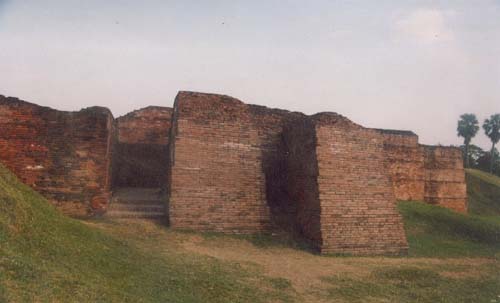Chandraketu Fort

Information on Chandraketu Fort (Kolkata, West Bengal) - History & Architecture
Chandraketu's Fort is basically a place which is characterised by ruins of a big area characterised by various ancient constructions of 6th century. Situated in Berachampa village of North 24 Paragana of West Bengal, Chandraketu's Fort was established by king Chandraketu. The site is popular for archaeological excavations which discovered an affluent urban defrayal.
Chandraketu Fort Architecture
The area of Chandraketu's Fort contains ancient residence along with various objects of people who lived there during the period of 6th century. Chandraketu's Fort is characterised by brick glided ware along with fragments of rouletted ware. It contains droplets, punch marked coins and cast copper coins which was used for trade on that time. This historical site has bring forth attractive terracotta ceramics from the era of Maurya, Sunga and Kushana. Presently these objects are collected and demonstrated in the museum of Kolkata. The protected boundary of Chandraketu's Fort involves of an earthen fortification only.
In Chandraketu's Fort, there was ancient fortified parapets, which was believed to be a pathway for people. Presently, it was converted into a nice tree lined trail. The fort is greatly susceptible to pilferage and deterioration. In Chandraketu's Fort, there is a sanctuary named Paresnath Temple which is regarded as a popular archaeological site of that area. The temple has a four feet tall wall and disclose the splendour of traditional period. However, at present only a voyage of stairs and the remnants of the building remains. Other popular constructions which have been discovered through the excavation of Chandraketu's Fort are Budhha stupa and images along with various attractive designs which belong to Pala era.
Chandraketu Fort History
Chandraketu's Fort is a legendary place which was partially excavated by the 'University of Calcutta' during the period of 1956 to 1967. Till then Chandraketu's Fort has revealed almost constant sequence of works which was divided into 6 eras ranging from Pre-Mauryan era to Pala era. According to archaeologists, Chandraketu was a prosperous urban area which thrived from 4th century BC to 12th century AD. Many years of diggings in that area exposed leftovers of several historical eras which existed about 2500 years ago. Historians believe that there exist a remarkable civilisation, which stand as a silent viewer, casing up centuries of tradition.
The first phase of excavation in Chandraketu's Fort exposed highly evolved Buddhist civilisation. The leftovers of Budhha stupa in Chandraketu's Fort possibly belong to Gupta era, which dates back to about 1st and 2nd century BC. It is regarded as the first proof of Buddhism in West Bengal. From the discovery of melted metals such as silver and iron, historians also believe that it was the leftovers of ancient furnace.
In Chandraketu's Fort, there is also evidence of sovereignty of Ballal Dhipi, who belong to Sen Family. Ballal Dhipi reigned Bengal during the period of 12th century AD. During the second phase of excavations, various remnants and stuffs were discovered which dated back to the year of 400 BC to 1000 BC. On the basis of some historians, Chandraketu's Fort is also a place which was well-known to prehistoric Greek and Roman novelists.
Chandraketu Fort Tourism Importance
Chandraketu's Fort is open for public view and is regarded as great place for tourism. Students of archaeology can find this site fairly stimulating to visit. Furthermore, people who are interested in history can also be attracted by the sight of Chandraketu's Fort. Besides, there are various other nearby attractions in Chandraketu's Fort which makes it perfect for causal tourists as well as family travellers.
- Andaman Nicobar Monuments
- Andhra Pradesh Monuments
- Assam Monuments
- Bihar Monuments
- Chhattisgarh Monuments
- New Delhi Monuments
- Goa Monuments
- Gujarat Monuments
- Haryana Monuments
- Himachal Pradesh Monuments
- Jammu and Kashmir Monuments
- Karnataka Monuments
- Kerala Monuments
- Madhya Pradesh Monuments
- Maharashtra Monuments
- Odisha Monuments
- Punjab Monuments
- Rajasthan Monuments
- Tamil Nadu Monuments
- Telangana Monuments
- Uttar Pradesh Monuments
- West Bengal Monuments